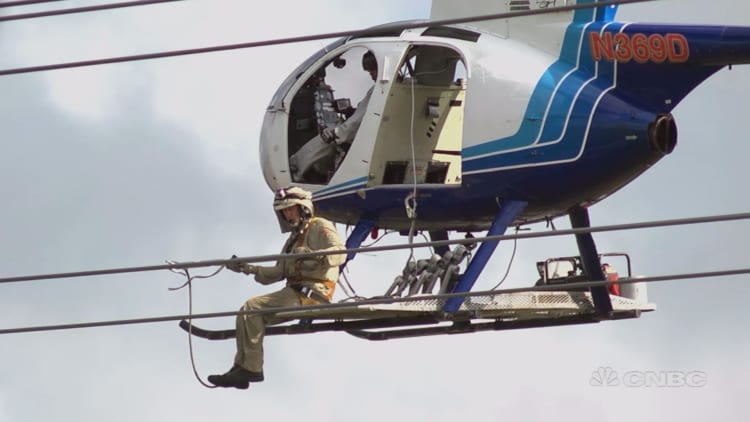Helicopters, chainsaws and power-lines aren’t usually a safe combination, but for the skilled team of workers at Haverfield Aviation, it’s just another day on the job.
“There’s little chance of survival if you get into something bad. You can lose arms and legs… you’re not going to go home from it,” says employee John Brooks.
Power-line installers and repairers have one of the 10 most dangerous occupations in America, with significant rates of both fatal and non-fatal injuries, according to the Bureau of Labor Statistics. Brooks and his teammates are highly-skilled aerial linemen who specialize in servicing power-lines that can only be accessed by chopper in some of the country’s most unforgiving terrain. CNBC cameras followed the crew as they worked high above the Appalachian Mountains in West Virginia.
Helicopters are dangerous and power-lines are dangerous. When you put the two together, you have double danger...John BrooksAerial Lineman,Haverfield Aviation
“You have to always be alert, always be on your A-game. It [doesn't] take much voltage to stop your heart.”
Brooks is right — dozens of power-line workers die each year, and for the team at Haverfield Aviation, the danger is amplified even further.
Most of their work is done while dangling from a helicopter hundreds of feet in the air, sometimes wielding high-powered tools like chainsaws – all at an elevation that pilots call "the Deadman’s curve." It’s an altitude and airspeed combination that pilots are taught to avoid in flight school and which could result in a potentially fatal situation, like engine failure or a crash. Haverfield’s pilots are trained to maneuver under these trying conditions, and take extra safety measures during these operations.
“When I’m about to do something and I think, 'If I cut this corner I could get it done faster,' I remember my kids and my wife at home, and that stops me dead in my tracks," says Brooks. "I don’t want my kids standing over my casket crying ‘cause Daddy took a shortcut."
Despite the dangers, Brooks says he knew he wanted the job the moment he saw the Haverfield Aviation team in action.
“Where I live, there’s not a whole lot of jobs, so the good lord really blessed me," says Brooks, who had never been on an airplane before he landed the job. "Truth of it is, people [go] to Six Flags and pay a [lot of] money to get to take a little old ride. And I get paid to do something even better than any of that.”
The average power-line worker makes around $67,000 a year depending on their region, but aerial linemen can make a lot more. “I probably make around $90,000 to $100,000 a year, and I’m not one of the top-paid guys,” says Brooks.
Still he says, it’s not all about the money. “Keeping the infrastructure up, keeping the national grid going is very important. I could get emotional thinking about it. But I am privileged — I’ve been blessed."
—CNBC's contributed to this report.
Like this story? Subscribe to CNBC Make It on YouTube!



